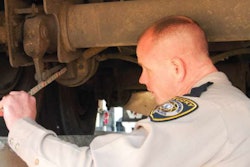International Roadcheck is happening after all this year.
In March, the Commercial Vehicle Safety Alliance announced it was postponing its annual International Roadcheck because of the COVID-19 coronavirus pandemic. CVSA today announced it has rescheduled International Roadcheck for Sept. 9-11.
International Roadcheck is what the CVSA calls “a 72-hour high-volume, high-visibility inspection and enforcement initiative” during which CVSA-certified inspectors in the U.S., Canada, and Mexico conduct commercial motor vehicle and driver inspections at weigh or inspection stations, at designated fixed locations or as part of mobile patrols. During those three days, law enforcement personnel will inspect commercial motor vehicles for compliance with federal regulations and utilize the North American Standard Out-of-Service Criteria to identify critical inspection item violations.
Each year, International Roadcheck places special emphasis on a category of violations. This year’s focus is on the driver requirements component of a roadside inspection. During last year’s Roadcheck, some 3.36 million inspections were conducted, and 952,938 driver violations were discovered, of which 199,722 were out-of-service conditions.
During Roadcheck, inspectors primarily conduct the North American Standard Level I Inspection, a 37-step procedure that includes two main inspection categories: an examination of driver operating requirements and vehicle mechanical fitness. A third category, hazardous materials/dangerous goods, may also be part of a Level I Inspection. Depending on weather conditions, available resources or personnel, or other factors, inspectors may opt to conduct the Level II Walk-Around Driver/Vehicle Inspection, Level III Driver/Credential/Administrative Inspection or Level V Vehicle-Only Inspection.
For the driver portion of an inspection, the inspector will collect and verify the driver’s documents, identify the motor carrier, examine the driver’s license, check record of duty status and review periodic inspection report(s). If applicable, the inspector will check the Medical Examiner’s Certificate, Skill Performance Evaluation Certificate and the driver’s daily vehicle inspection report. Inspectors will also check drivers for seat belt usage, illness, fatigue, and apparent alcohol or drug possession or impairment.
Drivers found to be operating without the proper driver credentials; in possession of or under the influence of drugs or alcohol; operating while ill, fatigued or showing other signs of impairment; or in violation of hours-of-service rules may be placed out of service.
The vehicle portion of an inspection includes checking critical vehicle inspection items such as: brake systems, cargo securement, coupling devices, driveline/driveshaft components, driver’s seat (missing), exhaust systems, frames, fuel systems, lighting devices, steering mechanisms, suspensions, tires, van and open-top trailer bodies, wheels, rims and hubs, and windshield wipers.
If an inspector identifies critical inspection item violations that meet the North American Standard Out-of-Service Criteria during a vehicle inspection, the inspector will render the vehicle out of service, which means that vehicle will be restricted from traveling until those violations are corrected.











